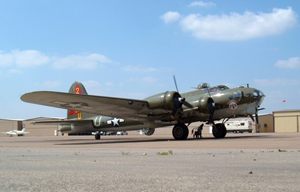
“I can’t risk another 8 feet of water being in the facility,” said the museum’s executive director, Larry Gregory.
The Houston Chronicle reported that the museum will be relocated to Houston’s Ellington International Airport, a former military field. Gregory said construction should begin in about 18 months and the move could take three years.
Last week, the Houston City Council approved a 40-year contract with the museum for 14 acres at Ellington, said Ian Wadsworth, chief commercial officer for the Houston Airport System. The contract commits the museum to making at least $7.5 million in improvements.
Gregory said that the $15,000 annual rent is about the same it’s paying at Scholes International Airport in Galveston.
At Ellington, the museum’s 13 flying and six display aircraft will join a half-dozen Vietnam War-era aircraft owned by the Collings Foundation-Houston and a growing collection of vintage military aircraft owned by the Texas Flying Legends.
Gregory said the new Lone Star Flight Museum and hangar will be bigger, more modern and add a theater and a restaurant. He said the decision to leave Galveston was bittersweet though.
“Galveston is a big part of our history,” he said. “You kind of hate to let them down.”
Officials in Galveston, where the museum has been a tourist attraction since 1990, are unhappy but understanding about the museum’s decision.
“Everyone wants the museum to stay, but we understand what they have to do,” said Leah Cast, spokeswoman for the island’s Convention and Visitors Bureau. “The most important thing for the flight museum, and everyone in Galveston, is that those aircraft are protected.”
Cast said the museum’s 50,000 visitors each year is tiny when compared to the 5 million tourists who visit the island annually. And, she said, many of the museum’s visitors come first to see the nearby Moody Gardens and the Schlitterbahn Galveston Island Indoor Waterpark.
Gregory said Hurricane Ike destroyed several small experimental aircraft and submerged some larger ones, including the museum’s World War II Spitfire, in corrosive saltwater.
The museum lost irreplaceable memorabilia such as a blood chit—a document asking civilians to assist downed pilots—carried by Flying Tiger ace David Lee “Tex” Hill over China as he battled the Japanese air force. Gregory said that Hill’s blood chit was written with Chinese characters printed on silk.
The Spitfire, which gained fame in the Battle of Britain, was disassembled by a crew that is cleaning and checking every part in a process that will take as long as four years.
Hud Hopkins, airport manager at Scholes, said he extended the museum’s lease by 20 years after the storm, but that wasn’t enough to keep it from moving. And the cost of making the museum storm-proof was prohibitive.
___
Information from: Houston Chronicle, http://www.houstonchronicle.com
Copyright 2011 Associated Press. All rights reserved. This material may not be published, broadcast, rewritten, or redistributed.
AP-WF-08-22-11 2023GMT

